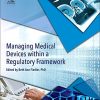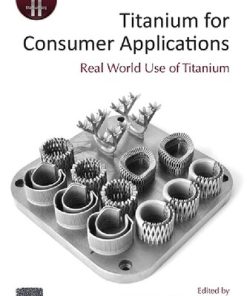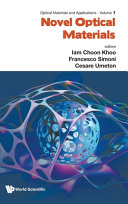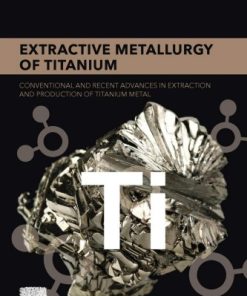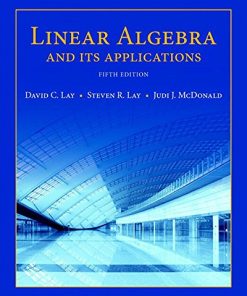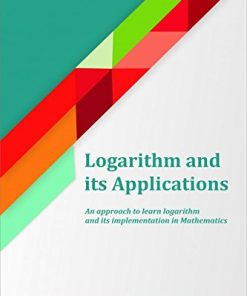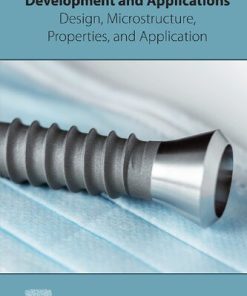(EBook PDF) Titanium Dioxide TiO2 and Its Applications 1st edition by Francesco Parrino, Leonardo Palmisano 0128204346 9780128204344 full chapters
$50.00 Original price was: $50.00.$25.00Current price is: $25.00.
Titanium Dioxide (TiO2) and Its Applications 1st edition by Francesco Parrino, Leonardo Palmisano – Ebook PDF Instant Download/DeliveryISBN: 0128204346, 9780128204344
Full download Titanium Dioxide (TiO2) and Its Applications 1st edition after payment
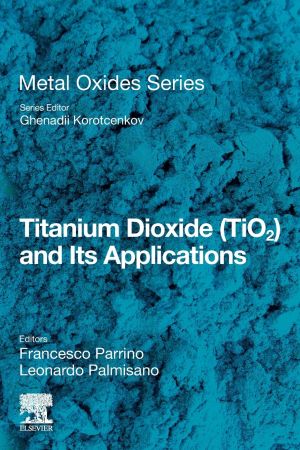
Product details:
ISBN-10 : 0128204346
ISBN-13 : 9780128204344
Author: Francesco Parrino, Leonardo Palmisano
Scientific interest in TiO2-based materials has exponentially grown in the last few decades. Titanium Dioxide (TiO2) and Its Applications introduces the main physicochemical properties of TiO2 which are the basis of its applications in various fields. While the basic principles of the TiO2 properties have been the subject of various previous publications, this book is mainly devoted to TiO2 applications.
The book includes contributions written by experts from a wide range of disciplines in order to address titanium dioxide’s utilization in energy, consumer, materials, devices, and catalytic applications. The various applications identified include: photocatalysis, catalysis, optics, electronics, energy storage and production, ceramics, pigments, cosmetics, sensors, and heat transfer.
Titanium Dioxide (TiO2) and Its Applications 1st Table of contents:
Section 1: Titanium dioxide: synthesis and characterization
1. Introduction
Abstract
1.1 Economic aspects
1.2 Summary of the book
References
2. Properties of titanium dioxide
Abstract
2.1 Introduction
2.2 Structural properties
2.3 Structure and defects
2.4 TiO2 morphologies
2.5 Thermodynamic properties
2.6 Electronic properties
2.7 Electrical properties
2.8 Optical properties
2.9 Photon-induced behavior
2.10 Mechanical and rheological properties
References
3. Structural and electronic properties of TiO2 from first principles calculations
Abstract
3.1 Introduction
3.2 Electronic structure calculations on TiO2: methodological aspects
3.3 Titania heterojunctions and nanoparticles: computational modeling of cutting-edge materials
3.4 Conclusions
Acknowledgments
References
4. Synthesis and characterization of titanium dioxide and titanium dioxide–based materials
Abstract
4.1 Introduction
4.2 Preparation methods
4.3 Characterization techniques of TiO2
References
Section 2: Energy applications
5. Synthetic, natural and bioinspired dyes as TiO2 sensitizers in sustainable solar cells
Abstract
5.1 Introduction
5.2 Semiconductors
5.3 Dyes
5.4 Other functional materials
5.5 Assembly and characterizations for DSSCs
5.6 Conclusions
References
6. TiO2-based materials for photocatalytic hydrogen production
Abstract
6.1 Introduction
6.2 Photocatalytic water splitting with TiO2
6.3 Development of sensitive TiO2-based photocatalysts for H2 generation
6.4 Separation of photogenerated charges in TiO2-based photocatalysts for H2 generation
6.5 Sacrificial agents in photocatalytic hydrogen production: from overall water splitting to biomass reforming
6.6 Conclusion and perspectives
References
7. TiO2-based devices for energy-related applications
Abstract
7.1 Introduction
7.2 Energy storage applications
7.3 Conclusion and outlook
References
8. Heat transfer by using TiO2 nanofluids
Abstract
List of abbreviations
8.1 Introduction
8.2 Preparation and characterization of TiO2 nanofluids
8.3 Heat conduction in TiO2 nanofluids
8.4 Heat convection in TiO2 nanofluids
8.5 Boiling heat transfer of TiO2 nanofluids
8.6 Applications of TiO2 nanofluids
8.7 Future investigations
References
Section 3: TiO2 in our life
9. TiO2 as white pigment and valorization of the waste coming from its production
Abstract
9.1 Introduction
9.2 Routes for the manufacture of titanium dioxide pigments (Pigment White 6)
9.3 Properties and applications of Pigment White 6
9.4 Valorization of coproducts and wastes generated
References
10. Titanium dioxide–based nanomaterials: application of their smart properties in biomedicine
Abstract
10.1 Introduction
10.2 Smart properties of titanium dioxide–based nanomaterials
10.3 Tissue engineering
10.4 Drug delivery
10.5 Other applications
10.6 Conclusion and perspectives
References
11. TiO2 in the food industry and cosmetics
Abstract
11.1 Introduction
11.2 Titanium dioxide as food additive
11.3 Titanium dioxide for food preservation
11.4 Titanium dioxide in cosmetics and personal care products
11.5 Conclusion
References
12. Titanium dioxide: antimicrobial surfaces and toxicity assessment
Abstract
12.1 Introduction
12.2 Antibacterial and antimicotic properties
12.3 Toxicity assessment on TiO2 NPs
12.4 Antimicrobial surfaces
12.5 Conclusion
Conflicts of interest
Acknowledgments
References
13. Functionalization of glass by TiO2-based self-cleaning coatings
Abstract
13.1 Introduction
13.2 Main principle behind self-cleaning behavior
13.3 Applications of self-cleaning glass and main commercial products
13.4 Doped TiO2–based coatings for improved self-cleaning ability
13.5 Future tendencies: multilayer coatings for multifunctional glass
13.6 Conclusion
References
14. TiO2 as a source of titanium
Abstract
14.1 TiO2 production from titanium minerals
14.2 The Kroll process from TiO2 to Ti
14.3 Electrolytic production of Ti from TiO2 in high-temperature molten salts
14.4 Electrodeposition of Ti in low-temperature liquid salts
Acknowledgments
References
15. TiO2 in the building sector
Abstract
15.1 Introduction
15.2 TiO2 in cement-based materials
15.3 TiO2 in geopolymers
15.4 TiO2 in ceramic tiles
15.5 TiO2 in cultural heritage conservation
15.6 Environmental and health concerns in the use of TiO2 in building materials
15.7 Conclusion and perspectives
References
Section 4: TiO2 devices and their applications
16. TiO2 oxides for chromogenic devices and dielectric mirrors
Abstract
16.1 TiO2 in electrochromic devices
16.2 TiO2 in photo-electrochromic devices
16.3 TiO2 optical properties
16.4 Modeling distributed Bragg reflectors
16.5 Bloch surface waves and microcavity modes
16.6 Conclusion
References
17. TiO2 in memristors and resistive random access memory devices
Abstract
17.1 Introduction
17.2 Fundamentals on resistive switching
17.3 TiO2 in memristors and resistive random access memories: fabrication methods and performances
17.4 Conclusions and perspectives
References
18. Applications of TiO2 in sensor devices
Abstract
List of abbreviations
18.1 Introduction
18.2 Titanium dioxide in sensor field: principles and mechanisms of action
18.3 Gas sensors
18.4 Biosensors
18.5 Sensors for environmental applications
18.6 Fabrication of nanoscale sensors and future prospects
18.7 Conclusion
References
19. TiO2 photocatalysis for environmental purposes
Abstract
19.1 General overview on air and water pollution
19.2 General remarks on advanced oxidation processes
19.3 TiO2 photocatalysis for the removal of volatile organic compounds from gaseous stream
19.4 TiO2 photocatalysis for indoor air purification
19.5 TiO2 photocatalysis for the removal of organic pollutants from water and wastewater
19.6 Conclusion and future perspectives
References
20. Fine chemistry by TiO2 heterogeneous photocatalysis
Abstract
20.1 Introduction
20.2 Reactions of partial oxidation
20.3 Reactions of partial reduction
20.4 Reactions of alkylation
20.5 Conclusion
References
21. Catalytic applications of TiO2
Abstract
21.1 Introduction
21.2 Titania as catalytic support: role of the strong metal–support interaction
21.3 The role of defects on catalytic performances
21.4 Main reactions involving titania-based catalyst
21.5 Conclusion and outlooks
People also search for Titanium Dioxide (TiO2) and Its Applications 1st:
titanium dioxide tio2 and its applications pdf
applications of titanium dioxide
titanium dioxide process
titanium dioxide is used as
is titanium dioxide safe
Tags:
Titanium Dioxide,Applications,Francesco Parrino,Leonardo Palmisano
You may also like…
Engineering
Titanium for Consumer Applications: Real-World Use of Titanium 1st Edition Francis Froes
Children's Books - Education & Reference
Uncategorized


